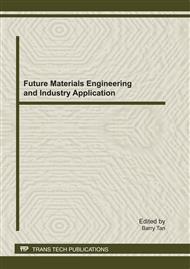[1]
Premuzic ET, Mow SL, Zhou WM, Bioconversion reactions in asphaltenes and heavy crude oils. Energy & Fuels. 1999a, 13: 297-304.
DOI: 10.1021/ef9802375
Google Scholar
[2]
Premuzic ET, Mow SL Induced biochemical conversions of heavy crude oils. Journal of Petroleum Sciences and Engineering. 1999b, 22: 171-180.
DOI: 10.1016/s0920-4105(98)00066-7
Google Scholar
[3]
Wang QH, Fang XD, Bai BJ, Liang XL, Shuler PJ, for production of rhamnolipid as an agent for enhanced oil recovery. Biotechnology and Bioengineering. 2007, 98: 842-853.
DOI: 10.1002/bit.21462
Google Scholar
[4]
Youssef N., Elshahed MS, McInerney MJ, Microbial processes in oil fields: culprits, problems, and opportunities. Adv Appl Microbiol, 2009, 66: 141-251.
DOI: 10.1016/s0065-2164(08)00806-x
Google Scholar
[5]
Behlulgil K, Mehmetoglu T, Donmez S, Application of microbial enhanced oil recovery technique to a Turkish heavy oil. Applied microbiology and biotechnology. 1992, 36: 833-835.
DOI: 10.1007/bf00172204
Google Scholar
[6]
Xia Ying, Min Hang, Rao Gang, Li Zhen-mei, Liu Ji, Ye Yang-fang and Duan Xue-jun, Isolation and characterization of phenanthrene-degrading Sphingomonas paucimobilis strain ZX4. Biodegradation. 2005, 16: 393–402.
DOI: 10.1007/s10532-004-2412-7
Google Scholar
[7]
Zhao He-Ping, Wu Qing-Sheng, Wang Lei, Zhao Xue-Tao, Gao Hong-Wen, Degradation of phenanthrene by bacterial strain isolated from soil in oil refinery fields in Shanghai China. Journal of Hazardous Materials. 2009, 164: 863–869.
DOI: 10.1016/j.jhazmat.2008.08.098
Google Scholar
[8]
Fan TG, Buckley JS, Rapid and accurate SARA analysis of medium gravity crude oils. Energy & Fuels 2002, 16: 1571–1575.
DOI: 10.1021/ef0201228
Google Scholar
[9]
Liu JF, Ma LJ, Mu BZ, Liu RL, Ni FT, Zhou JX, The field pilot of microbial enhanced oil recovery in a high temperature petroleum reservoir. Journal of Petroleum Science and Engineering. 2005, 48: 265-271.
DOI: 10.1016/j.petrol.2005.06.008
Google Scholar
[10]
Widdel F, Rabus R, Anaerobic biodegradation of saturated and aromatic hydrocarbons. Current Opinion in Biotechnology. 2001, 12: 259–276.
DOI: 10.1016/s0958-1669(00)00209-3
Google Scholar
[11]
Premuzic ET, Lin MS, Lian H, Zhou WM, Yablon J, The use of chemical markers in the evaluation of crude oil bioconversion products, technology, and economic analysis. Fifth International Symposium on the Biological Processing of Fossil Fuels, Madrid, Spain, FUEL, (1996).
DOI: 10.1016/s0378-3820(97)00030-1
Google Scholar
[12]
Lin MS, Premuzic ET, Yablon JH, Zhou WM, Biochemical processing of heavy oils and residuum. J Appl Biotechnol Biochem. 1996, 57-58: 659–664.
DOI: 10.1007/bf02941747
Google Scholar
[13]
Haritash AK, Kaushik CP, Biodegradation aspects of polycyclic aromatic hydrocarbons (PAHs): a review. Journal of Hazardous Materials. 2009, 169: 1–15 Figure 1 Difference in composition (SARA) of crude oil before and after biodegradation Figure 2 Viscosity reduction curve of heavy oil after biodegradation using S17 and S28.
DOI: 10.1016/j.jhazmat.2009.03.137
Google Scholar


